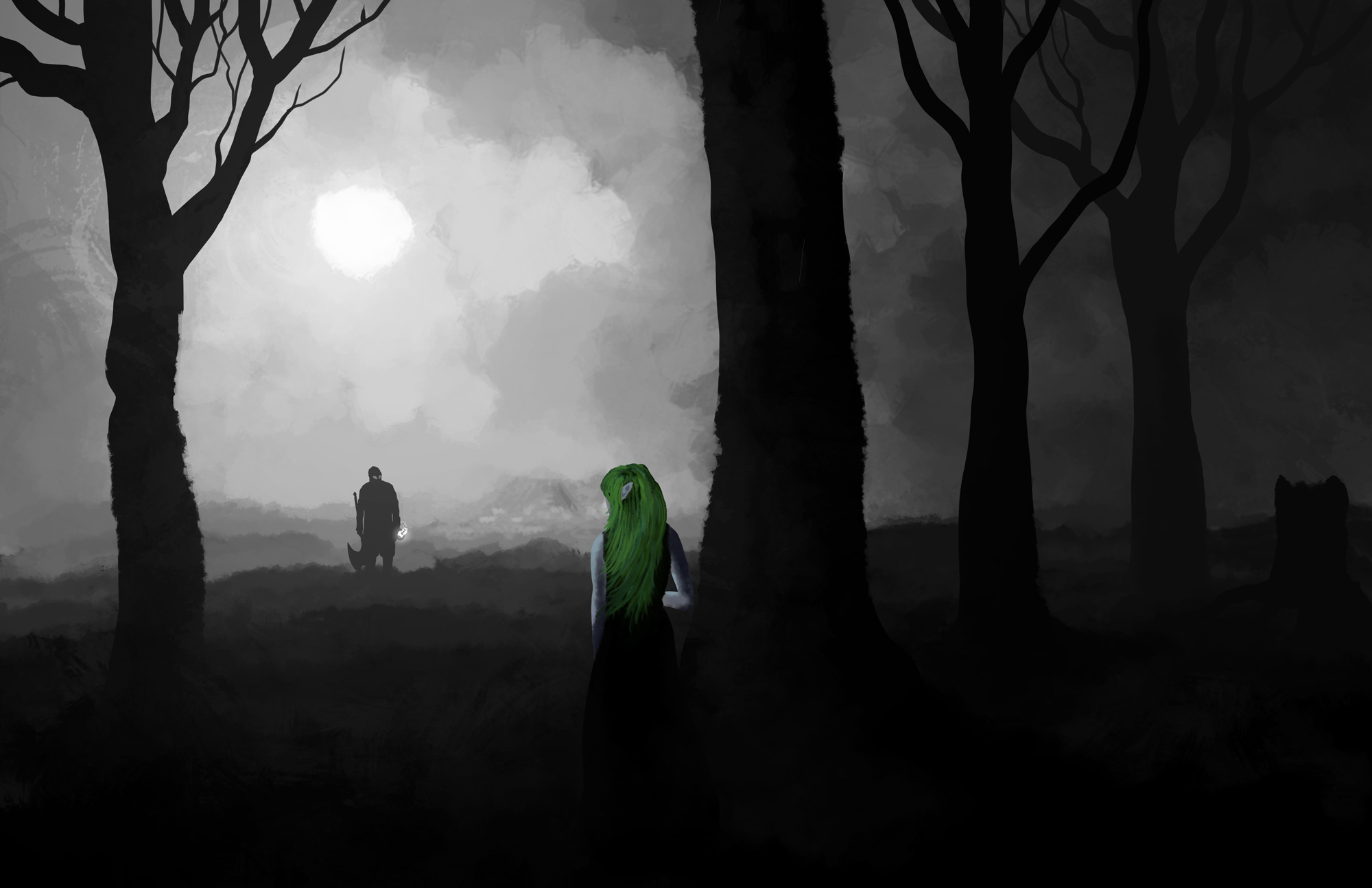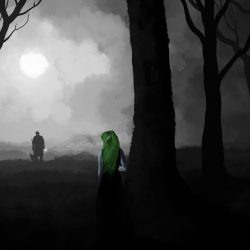Additional Mechanics
Actions and Turns
All characters have two actions at base, one mundane and one supernatural, with the exception of mundane Minor Actors, who lack a supernatural action. These actions are resolved simultaneously, but one or both may be held until later in the initiative.
A turn in Huldufolk lasts 10 seconds, characters can generally move freely, though at the ST’s discretion for full distance. As a general rule, a character who takes an action and moves can travel about 10 meters, while a character who devotes their entire turn to movement can travel around 30 meters. These numbers are not exact, as movement is not a primary mechanic in the Huldufolk system.
Initiative
Initiative in Huldufolk is done by playing a card. All characters acting in the combat play a card, and simultaneously reveal what card was selected. Ties are resolved by each tied player drawing a card from the ST’s deck and comparing. This card is not lost, as though it were used in a challenge, but become inaccessible to the character for the duration of the combat. When the combat has concluded, the character reclaims their initiative card, adding it back to their hand.
Demesne
A character’s Demesne is their home base. At creation, a character can have only one Demesne, typically it’s wherever they spend the majority of their time. A character’s Demesne has a maximum size of their Personal Influence. The building may be larger, but only that portion is recognized by the strange rules which govern Huldufolk magic.
Over time, a character’s Demesne changes to suit them. It may take on an otherworldly beauty, hinting at their angelic origins, or a sinister feeling of fear may pervade every surface. Either way, as the character’s hold over a Demesne increases, they find that their chosen Sphere begins to assert a hold over it. All characters in the Demesne receive a +1 to actions which match the owner’s primary Sphere, as though they were benefiting from one level of that Sphere’s Lesser Path. This bonus increases to +2 at Belief 3 and +3 at Belief 5.
Additionally, the area surrounding a character’s Demesne begins to be influenced by that character’s power as well. The character’s Territorial Influence begins to shape the thoughts and actions of Minor Actors who spend significant time in the territory.
Example of Mundane Defense:
Bob the Elf has drawn the ire of three hexenwolves (Minor Actors, supernatural). He’s a Stalwart defender (+3), armored (+1), and hasn’t faced an attack in the last 10 minutes (base +5). The hexenwolves are Vicious attackers (+3), wielding knives (+1), and have Focused on Melee combat (+2).
In the first round of combat, all three wolves attack Bob. His player recognizes that they’re Minor Actors, and therefore much more limited than he. On the first attack, the wolf selects its highest card (+5) while Bob plays from the low end of his deck (+2). The two add their cards to their pools and determine that the Wolf’s total is 11, while Bob’s total is also 11. As Bob is defending, the wolf’s attack is narrowly avoided. On the second attack, Bob no longer has his 2 card, and his threshold has been reduced by 1. However, his player is fairly certain they have the measure of these wolves, and selects the 3 card. As before, the wolf plays their highest card and achieves an 11, matched by Bob, who has a lower base (now +4), but played a higher card to mitigate the attack. The pattern repeats with the third wolf, Bob’s threshold is now +3, and he selects his 4 card to keep the beast from hitting him.
On Bob’s action, he has a difficult choice to make. He’s reasonably confident that he can hit one of the wolves if he really swings for the fences, but he has no Qualities or affinities relevant to attacking, and his only weapon is a short sword (+1). He doesn’t know for sure what the wolves’ defenses are, but he knows that hitting them will likely require at least his 6 card15 base threshold + at least 1 from the card, defender wins ties., given that most creatures have a base threshold of +5. He decides that it’s better to attempt the attack than simply stand there while being shredded. Rather than go with the minimum possible card, he swings for the fences. The ST, deciding for the wolf in question, believes that Bob’s player will continue to try and eke out small victories, and selects the wolf’s Ace card. The wolf is a berserker, and has no appropriate defensive qualities or armor. Therefore its defense is entirely based on its threshold, currently a +52Though the wolf has been active in combat, the threshold is only reduced by being the *target* of attacks, which until now hadn’t happened.. Bob and the ST build their pools, to the ST’s surprise, Bob swings with an uncharacteristically high 11, while the wolf has a mere 6. Because he exceeded the target by 5, Bob’s attack inflicts two damage, enough for the relatively fragile wolf to be brought down.
In round two, Bob faces only two wolves, but he’s already starting to tire from the strain of fighting off the wolf pack. His threshold is now down to a +2, and he’s starting to burn through his cards. The two wolves attack with their highest remaining cards (4 for each), while he’s forced to use even higher cards to resist (5 for the first, 6 for the second). When his turn to attack comes up, he decides his best bet is to use his Ace for the attack. He knows he won’t hit, but he doesn’t want to waste his dwindling card supply. The ST, based on his previous attack, expects Bob to play a high card, and spends his highest remaining card for that wolf (3). The two compare pools once more, Bob’s total of 2 isn’t high enough to hit the wolf’s defense of 8, but he takes solace in knowing that the beast is running out of cards.
Round three, the two wolves attack again, one spending 2 and one spending 3. Bob’s threshold is now at 0, which means his defenses are at 4 (Quality + Armor), but they won’t be going any lower. The wolves’ attack pools are still at 6 before the card, which is higher than Bob’s Ace defense (5 total), which means he has to either spend his few remaining high cards, or take some hits. However, now that he knows their resources are depleted, and that he’s not at risk of taking multiple damage per hit, he’s willing to take a bit of damage in hopes of putting the pair down. He spends his Ace on both attacks, taking 1 damage from each, and uses his 9 to hit the wolf he attacked previously, who now has a threshold of 4 and only an Ace remaining. The wolf’s total defense is 5, while Bob’s attack is at a 10. This wolf, like the last, is brought down.
Round four, there’s only one wolf, and Bob’s defenses remain unchanged. Realizing that it is unable to do enough damage to bring him down before he destroys it, the ST decides that the wolf is going to flee. While Bob could give chase, his player decides not to risk walking into another ambush and lets it escape.
As should be clear, even a small fight like this one was very nearly lethal to Bob, who only got through it with careful play and a bit of luck. Individually, the wolves would have been no challenge, but being outnumbered three to one had a major impact on the fight. In the real world, 5 good fighters will almost always defeat 1 great fighter, and the same is true in Huldufolk. Some of the most powerful warriors, or those blessed with truly remarkable Artifacts, may be able to handle a large group of enemies, but these characters are much more the exception than the rule. That said, characters willing to take a bit of a beating can still deliver dangerous blows to their adversaries on the way out.
Additionally, while a player needs to track only their thresholds, a storyteller with multiple NPCs needs to track thresholds for each, as well as the cards spend by each. With large groups, this can rapidly get out of hand. Huldufolk is not a system designed to replicate armies, and the paperwork involved is non-trivial.

